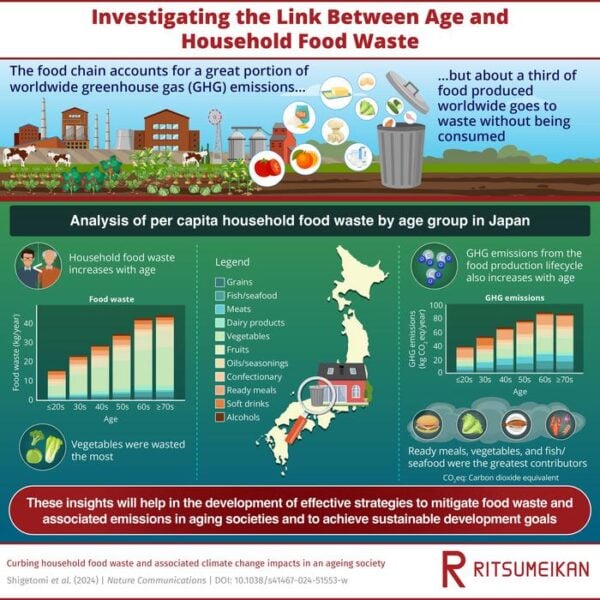New research uncovers a significant correlation between the age of household heads and the amount of food waste generated, with implications for climate change mitigation strategies.
Summary: A study published in Nature Communications shows that older households in Japan produce nearly twice as much food waste as younger ones, highlighting the need for targeted interventions to reduce waste and associated greenhouse gas emissions.
Estimated reading time: 6 minutes
As the global community grapples with the dual challenges of food waste and climate change, a new study from Japan sheds light on an unexpected factor influencing household food waste: age. Researchers from Ritsumeikan University and other Japanese institutions have discovered that the age of a household’s head significantly impacts the amount of food waste produced and its associated greenhouse gas emissions.
The Age Factor in Food Waste
The study, published in Nature Communications on October 21, 2024, reveals a striking trend: households headed by older individuals tend to generate substantially more food waste than their younger counterparts. According to the research, elderly households potentially produced nearly twice as much food waste compared to households where the head was in their 30s.
Dr. Yosuke Shigetomi, Associate Professor at Ritsumeikan University and lead researcher of the study, emphasizes the significance of this finding:
“An aging population would be one of the hidden but key factors for consideration when proposing strategies to reduce food waste directly generated by households.”
This insight is particularly relevant for Japan, which faces the challenges of an aging population and has reported significant household food waste. In 2021 alone, Japanese households generated an estimated 2.47 megatons of food waste, much of which was likely still edible.
Breaking Down the Waste
The research team analyzed over 2,000 food products, categorizing them and examining the relationships between food waste, age, and other socioeconomic factors. Their findings reveal that:
- Vegetables were the most frequently wasted food type across all age groups.
- Greenhouse gas emissions associated with food waste also increased with the age of the household head.
- Vegetables, ready meals, and fish and seafood were the biggest contributors to greenhouse gas emissions from food waste.
These results highlight the complex interplay between dietary habits, age, and environmental impact. Dr. Shigetomi notes:
“It will be essential to pay closer attention to the dietary preferences and lifestyles among different generations, particularly under the desire of dietary shifts towards vegetarianism for combating climate change.”
Implications for Policy and Practice
The study’s findings have significant implications for developing strategies to reduce food waste and mitigate its environmental impact. Some key considerations include:
- Targeted interventions: Policies and educational campaigns should be tailored to address the specific needs and habits of different age groups.
- Focus on high-impact foods: While vegetables are the most wasted food, meats contribute significantly to greenhouse gas emissions. Strategies should consider both quantity and environmental impact.
- Addressing an aging population: As Japan’s population continues to age, understanding the link between age and food waste becomes increasingly crucial for effective waste reduction strategies.
Future Directions
This research opens up new avenues for addressing food waste and its environmental consequences. Future studies might explore:
- The reasons behind increased food waste in older households (e.g., purchasing habits, cooking practices, portion sizes).
- The effectiveness of age-targeted interventions in reducing food waste.
- How these findings translate to other countries with aging populations.
As we strive to build more sustainable food systems, understanding the nuanced factors contributing to food waste is essential. This study provides valuable insights that can inform more effective strategies for reducing waste and its associated environmental impact, particularly in societies facing demographic shifts.
Quiz: Test Your Knowledge
- According to the study, which age group produced the most food waste per capita? a) 20s and younger b) 30s c) 50s d) 70s and older
- What type of food was most frequently wasted across all age groups? a) Meat b) Vegetables c) Fish and seafood d) Ready meals
- How much food waste was generated by Japanese households in 2021? a) 1.25 megatons b) 2.47 megatons c) 3.5 megatons d) 4.1 megatons
Answer key:
- d
- b
- b
Glossary of Terms
- Food waste: Edible food that is discarded or left to spoil rather than consumed.
- Greenhouse gas emissions: Gases that trap heat in the Earth’s atmosphere, contributing to global warming.
- Life cycle assessment: A method for assessing environmental impacts associated with all stages of a product’s life.
- Demographic shift: Changes in the composition of a population, such as aging or urbanization.
- Socioeconomic factors: Social and economic aspects that influence individual or group behavior and decision-making.
Enjoy this story? Get our newsletter! https://scienceblog.substack.com/


